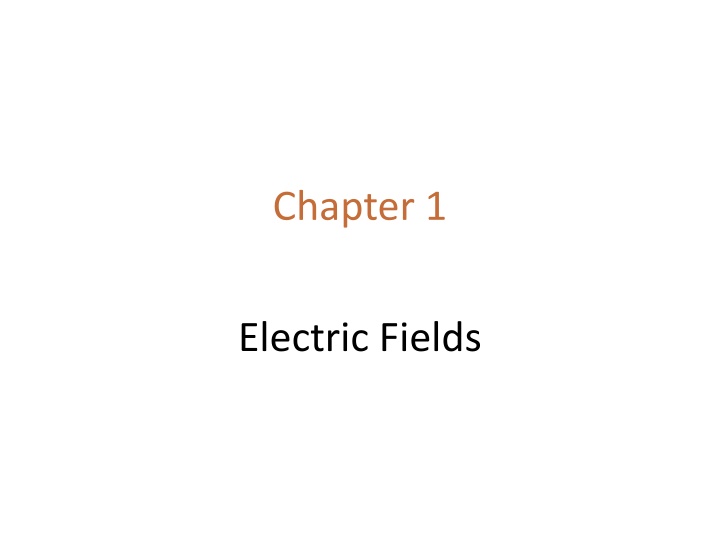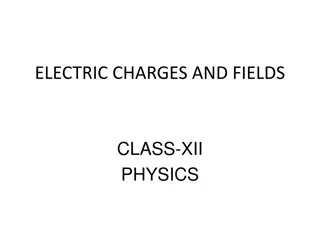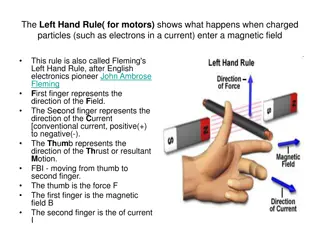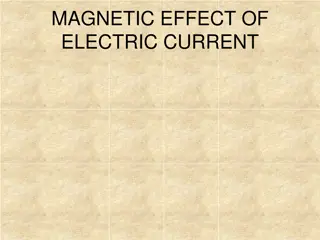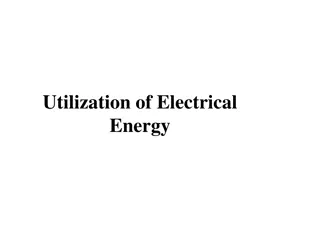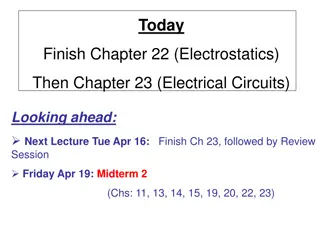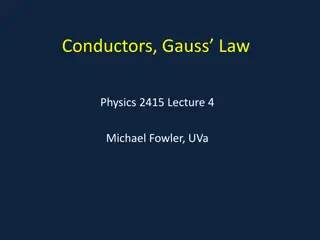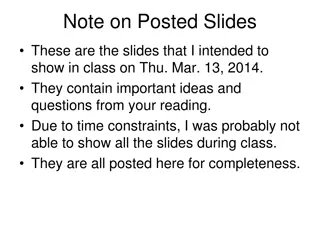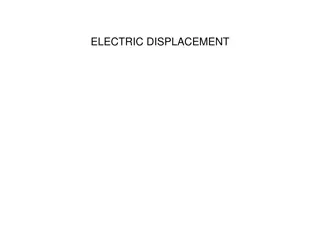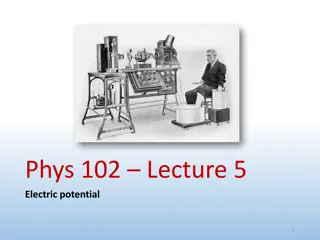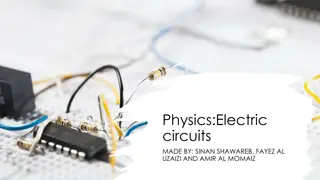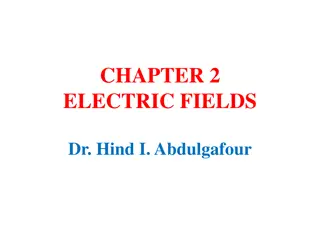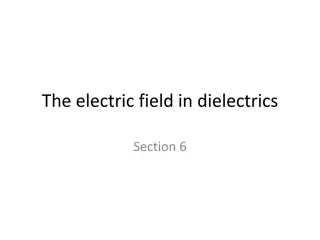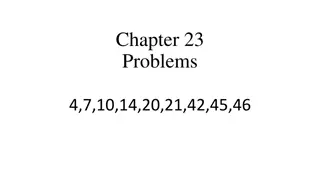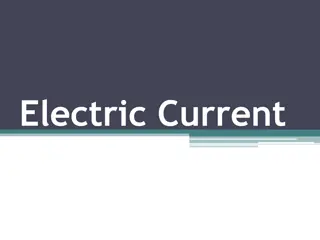Electric Fields: Chapter 1 Overview
Delve into the fundamental concepts of electric fields in Chapter 1 as we explore properties of electric charges, charging objects by induction, Coulomb's Law, the electric field, electric field lines, and the motion of charged particles in a uniform electric field. Discover how electric forces shape our understanding of nature through simple experiments and observations, illustrating the conservation of electric charge and the interactions between different types of charges.
Download Presentation

Please find below an Image/Link to download the presentation.
The content on the website is provided AS IS for your information and personal use only. It may not be sold, licensed, or shared on other websites without obtaining consent from the author.If you encounter any issues during the download, it is possible that the publisher has removed the file from their server.
You are allowed to download the files provided on this website for personal or commercial use, subject to the condition that they are used lawfully. All files are the property of their respective owners.
The content on the website is provided AS IS for your information and personal use only. It may not be sold, licensed, or shared on other websites without obtaining consent from the author.
E N D
Presentation Transcript
Chapter 1 Electric Fields
CHAPTER OUTLINE 1.1 Properties of Electric Charges 1.2 Charging Objects By Induction 1.3 Coulomb s Law 1.4 The Electric Field 1.5 Electric Field of a Continuous Charge Distribution 1.6 Electric Field Lines 1.7 Motion of Charged Particles in a Uniform Electric Field
The electromagnetic force between charged particles is one of the fundamental forces of nature. We begin this chapter by describing some of the basic properties of one manifestation of the electromagnetic force, the electric force. We then discuss Coulomb s law, which is the fundamental law of the electric force between any two charged particles. Next, we introduce the concept of an electric field associated with a charge distribution and describe its effect on other charged particles. We then show how to use Coulomb s law to calculate the electric field for a given charge distribution. We conclude the chapter with a discussion of the motion of a charged particle in a uniform electric field.
1.1 Properties of Electric Charges A number of simple experiments demonstrate the existence of electric forces and charges. For example; - after running a comb through your hair on a dry day, you will find that the comb attracts bits of paper. - The same effect occurs when certain materials are rubbed together, such as glass rubbed with silk or rubber with fur. Another simple experiment is to rub an inflated balloon with wool . The balloon then adheres to a wall, often for hours. When materials behave in this way, they are said to be electrified, or to have become electrically charged. In a series of simple experiments, it was found that there are two kinds of electric charges, which were given the names positive and negative by Benjamin Franklin (1706 1790). We identify negative charge as that type possessed by electrons and positive charge as that possessed by protons.
To verify that there are two types of charge, suppose a hard rubber rod that has been rubbed with fur is suspended by a sewing thread, as shown in Figure 1.1. When a glass rod that has been rubbed with silk is brought near the rubber rod, the two attract each other (Fig. 1.1a). On the other hand, if two charged rubber rods (or two charged glass rods) are brought near each other, as shown in Figure 1.1b, the two repel each other. This observation shows that the rubber and glass have two different types of charge on them. On the basis of these observations, we conclude that charges of the same sign repel one another and charges with opposite signs attract one another Figure 1.1 (a) A negatively charged rubber rod suspended by a thread is attracted to a positively charged glass rod. (b) A negatively charged rubber rod is repelled by another negatively charged rubber rod. rubbed with fur rubbed with silk
Another important aspect of electricity that arises from experimental observations is that electric charge is always conserved in an isolated system. That is, when one object is rubbed against another, charge is not created in the process. The electrified state is due to a transfer of charge from one object to the other. One object gains some amount of negative charge while the other gains an equal amount of positive charge. Figure 1.2 When a glass rod is rubbed with silk, electrons are transferred from the glass to the silk. Because of conservation of charge, each electron adds negative charge to the silk, and an equal positive charge is left behind on the rod. Also, because the charges are transferred in discrete bundles, the charges on the two objects are e, or 2e, or 3e, and so on. For example, when a glass rod is rubbed with silk, as in Figure 1.2, the silk obtains a negative charge that is equal in magnitude to the positive charge on the glass rod. We now know from our understanding of atomic structure that electrons are transferred from the glass to the silk in the rubbing process.
In 1909, Robert Millikan (18681953) discovered that electric charge always occurs as some integral multiple of a fundamental amount of charge e(see Section 3.7). In modern terms, the electric charge ? is said to be quantized, where ? is the standard symbol used for charge as a variable. That is, electric charge exists as discrete packets, and we can write ? ? = ? ?? ? , where ? is some integer. Other experiments in the same period showed that the electron has a charge ( ? )and the proton has a charge of equal magnitude but opposite sign +? . Some particles, such as the neutron, have no charge. From our discussion thus far, we conclude that electric charge has the properties :- Properties of electric charge There are two kinds of charges in nature; charges of opposite sign attract one another and charges of the same sign repel one another. Total charge in an isolated system is conserved. Charge is quantized.
1.2 Charging Objects By Induction It is convenient to classify materials in terms of the ability of electrons to move through the material: 1- Electrical conductors are materials in which some of the electrons are free electrons1 that are not bound to atoms and can move relatively freely through the material; 2- Electrical insulators are materials in which all electrons are bound to atoms and cannot move freely through the material. Materials such as glass, rubber, and wood fall into the category of electrical insulators. When such materials are charged by rubbing, only the area rubbed becomes charged, and the charged particles are unable to move to other regions of the material. In contrast, materials such as copper, aluminum, and silver are good electrical conductors. When such materials are charged in some small region, the charge readily distributes itself over the entire surface of the material. If you hold a copper rod in your hand and rub it with wool or fur, it will not attract a small piece of paper. 3- Semiconductors are a third class of materials, and their electrical properties are somewhere between those of insulators and those of conductors. Silicon and germanium are well-known examples of semiconductors commonly used in the fabrication of a variety of electronic chips used in computers, cellular telephones, and stereo systems. The electrical properties of semiconductors can be changed over many orders of magnitude by the addition of controlled amounts of certain atoms to the materials.
To Understand how to charge a conductor by a process know as induction, consider a neutral(uncharged) conducting sphere insulated from the ground, as shown in Figure 1.4a. Figure 1.4a There are an equal number of electrons and protons in the sphere If the charge on the sphere is exactly zero. When a negatively charged rubber rod is brought near the sphere, electrons in the region nearest the rod experience a repulsive force and migrate to the opposite side of the sphere. This leaves the side of the sphere near the rod with an effective positive charge because of the diminished number of electrons, as in Figure 1.4b.
